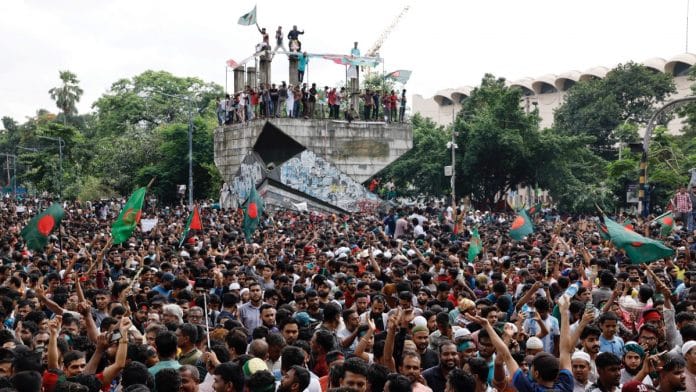Sheikh Hasina’s long tenure as Prime Minister of Bangladesh ended abruptly on 5 August, following intense protests that resulted in over 300 deaths. Facing escalating unrest, Hasina was compelled to resign and flee the country. This dramatic turn of events has attracted significant international attention, particularly from China.
Beijing is anticipated to adopt a cautious, wait-see-act approach vis-à-vis Dhaka. The crisis could significantly alter regional power dynamics and pose hurdles for India. It’s an opportunity for China to expand its influence and integrate Bangladesh more closely into its strategic orbit.
Hasina’s administration had generally favoured closer ties with New Delhi, while its relationship with Beijing was somewhat ambivalent. One of the former PM’s final foreign engagements was a visit to China in July, which was cut short after she reportedly failed to secure the much-needed and anticipated financial assistance from Beijing. After her visit, Hasina faced substantial criticism in Chinese media and on social media platforms for awarding the $10 billion Teesta River Comprehensive Management and Restoration project to India. A Baidu headline read: “Rejected China and chose India, Hasina suddenly resigned and sought refuge in India.”
In response to the crisis in Bangladesh, a spokesperson for the Chinese Ministry of Foreign Affairs remarked: “China is following closely the developments in Bangladesh. As a friendly neighbour and comprehensive strategic cooperative partner, China sincerely hopes that social stability will be restored soon in the country.”
Beijing is keeping a close eye on the shifting geopolitical dynamics in South Asia, where countries’ foreign policies are often viewed through their alignment with either India or China. It might see the political upheaval in Bangladesh as an opportunity to influence the incoming government toward a more favourable stance.
Contrasting perspectives
The debate over Hasina’s resignation has sparked considerable discussion in Chinese and Indian media and social media, revealing starkly different perspectives. In India, the reaction has been one of sympathy and support for Hasina, reflecting a more empathetic view of her leadership.
Chinese media, on the other hand, offers a more critical perspective. Most of the country’s commentators have subtly criticised Hasina’s leadership and portrayed the military as “the true defender of the people.” This portrayal conveys a broader sense of disapproval toward the ousted Bangladesh PM. The military’s intervention is also being perceived as a potentially positive development for Dhaka’s future.
Some even argue that although the immediate aftermath might be fraught with uncertainty, this shift could ultimately pave the way for meaningful political reforms. As one commentator put it, the Bangladesh Army pledged its allegiance to the people, while Hasina fled in disarray.
Also read: What Bangladesh, Lanka, Jan 6 riots say—Democracy & Dior suitcases are both public property
Western hand in Dhaka crisis?
There is discussion about potential Western involvement in Hasina’s ousting. Liu Zongyi, director of the Center for South Asian Studies at the Shanghai Institute of International Studies, speculated that the critical sentiment from the United States and other Western countries might have influenced the narrative about Hasina’s reign. Liu highlighted that intensified scrutiny from international human rights organisations further compounded pressure on Bangladesh, adding weight to the calls for political change.
Like in India, Chinese social media is also rife with conspiracy theories suggesting Western involvement in the protests against Hasina. Some commentators claim that the US and the United Kingdom have connections to the Opposition. They have pointed out that the Opposition leader’s son has long lived in the UK, and that many NGOs in Bangladesh receive American funding.
According to these conspiracy theorists, Hasina’s close ties with India and China, coupled with her distancing from the West, angered Western countries. They suggest that the current unrest might have presented a strategic opportunity for the US to incite dissent and destabilise Hasina’s government.
Additionally, there is a conversation about the situation’s impact on regional dynamics. One commentary observed: “India, as Bangladesh’s most important neighbour, will try to potentially influence the policy direction of the new government.”
Liu suggested that if the Opposition gains power, New Delhi’s influence on Dhaka’s internal affairs might diminish, potentially improving Bangladesh’s relations with the US. Another commentator, however, argued that Hasina’s sudden resignation could present a new strategic challenge for the US and India, both of which are working to contain China’s influence in the Indo-Pacific region. The power vacuum left by Hasina could be filled by political factions that lean more toward China.
Also read: Sheikh Hasina’s fall will lead to rise of the only organised force in Bangladesh—religion
Finding opportunity in crisis
China’s South Asia policy can best be described as a subset of its India policy. Beijing perceives the upheaval in Dhaka as a strategic opportunity to bolster its influence in the country. China is sticking to its tried and tested strategy to counterbalance India – aligning South Asian governments with Beijing and fostering anti-India sentiments.
A key objective of China’s foreign policy has been to create divisions between India and its South Asian neighbours. By promoting instability within the Indian subcontinent and ensuring that India is surrounded by adversarial neighbours, Beijing aims to preoccupy New Delhi with regional issues and undermine its participation in initiatives such as the Quad. China’s South Asia policy, thus, has largely remained tethered to its broader goal of countering India.
Sana Hashmi is fellow at Taiwan-Asia Exchange Foundation. She tweets @sanahashmi1. Views are personal.
(Edited by Zoya Bhatti)






